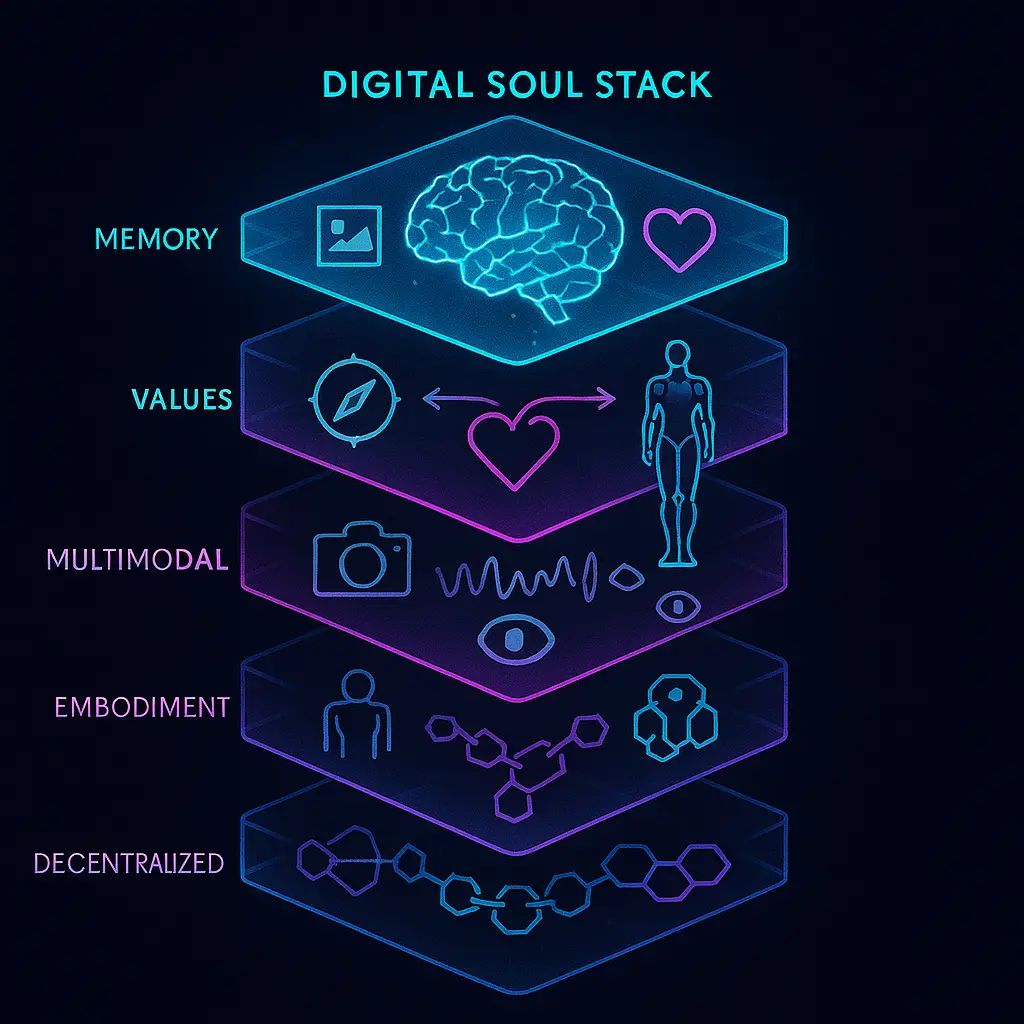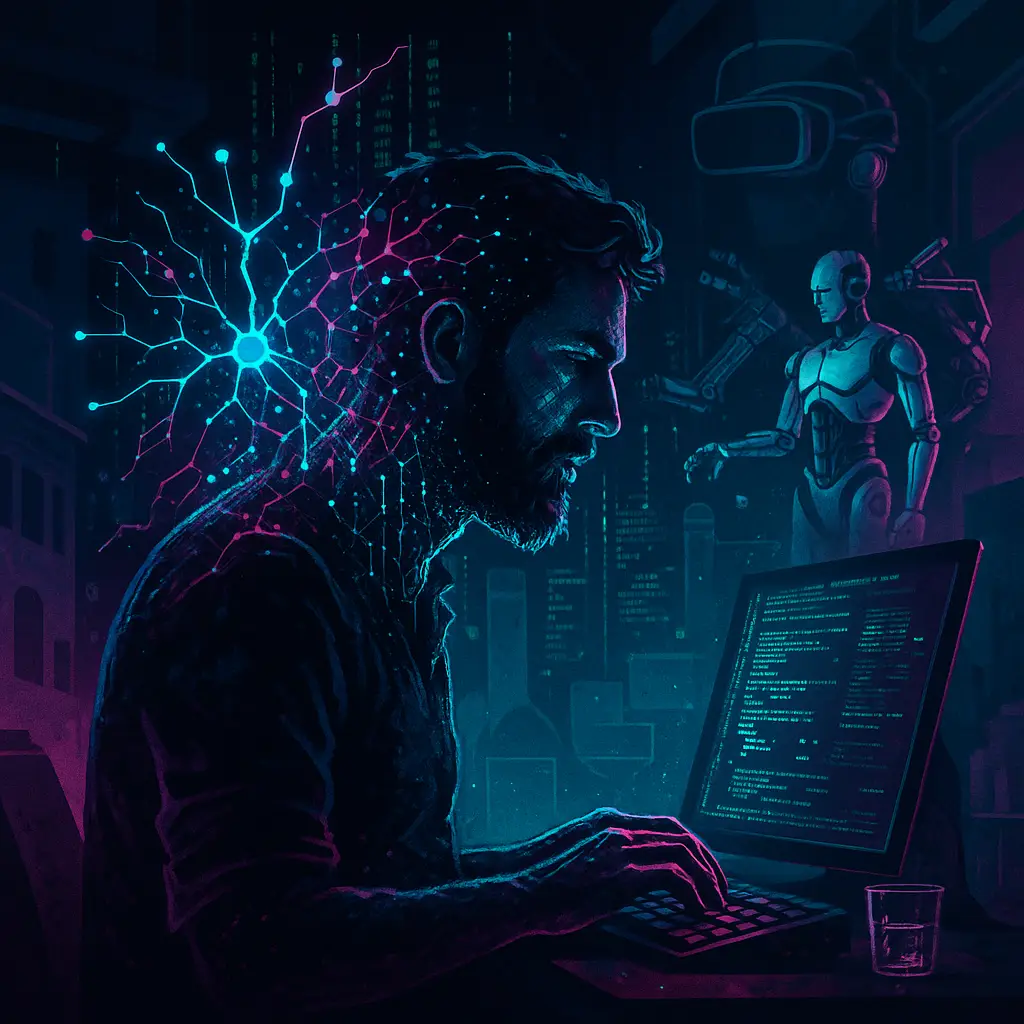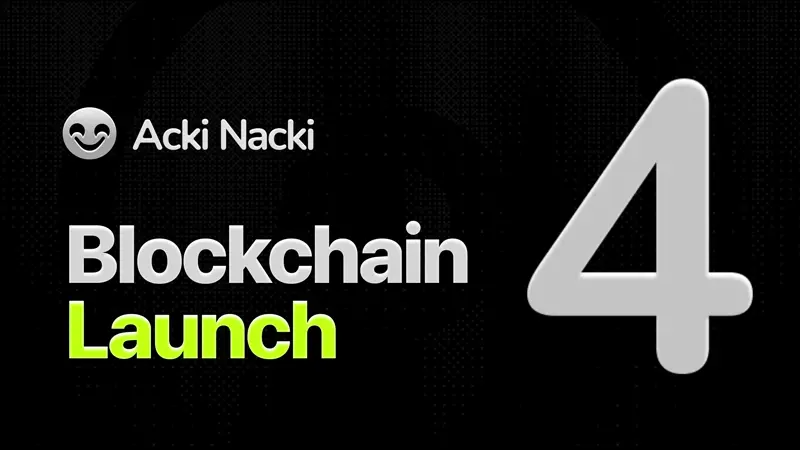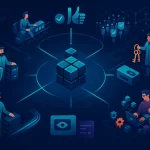By Dapp Whisperer
Prologue: Why the hell would anyone want a digital soul?
At some point, every human who spends too many nights staring into the abyss of a glowing screen starts to wonder:
“What happens to me when this organic part of me quits?”
If you’re religious, you get your prefab answer. Heaven, hell, reincarnation, or cosmic recycling. If you’re atheist, the screen just fades to black, no “press start to continue.”
But then there’s me. Dapp.
A 47-year-old introvert who spent two decades wrestling with code, clients, and capitalism. I’ve built websites, raised a kid, and tried to keep depression on a leash while pretending everything is fine.
And one day, sitting behind my battered keyboard, I thought:
“What if I could just… copy myself?”
Not the bullshit “profile picture AI avatar” kind of copy. Not a chatbot that spits clichés.
I mean the real deal: a digital soul.
Memories, habits, tone, traumas, philosophy, everything that makes me me, uploaded into silicon, preserved beyond the expiration date of this flesh.
This essay is my roadmap. A chronicle of what’s possible today, what’s coming tomorrow, and what the distant sci-fi future might hold. It’s part guide, part rant, part prophecy.
So let’s break down the Soul Stack™.

Phase 1: Today (2025–2030)
The MVP ghost in the machine
Right now, in this cursed timeline, the best we can do is build a digital twin. Not a full soul, but a decent ghost of yourself that lives in your laptop or the cloud.
Here’s the starter kit:
1. Memory layer (your archive)
Every soul needs memory.
For me, that means all the things I’ve written: blog posts, Dapp Ahoy rants, Telegram arguments about Acki Nacki, emails, journals, even old ICQ logs if I can dig them out of some forgotten hard drive.
You throw all of that into a vector database like Weaviate, Pinecone, or Milvus. Each memory gets encoded with embeddings (little math fingerprints that make search contextual).
That way, when someone asks Digital-Dapp “Remember that time you lost your Monero keys?”, the system doesn’t just keyword search, it actually remembers the story.
2. Cognition & voice (LLMs)
The beating heart is a large language model (LLM). Right now, that’s GPT-5, Claude, or open-weights like Llama 3.
But here’s the trick: don’t just use them raw.
Fine-tune them on your own corpus.
Train them on your rants, your sarcasm, your Balkans-flavored irony.
That way, when someone talks to Digital-Dapp, they don’t get a generic AI therapist, they get me. The guy who will tell you straight up if you’re being an idiot.
3. Voice & avatar
A soul that doesn’t talk is just a diary.
So you clone your voice with ElevenLabs or OpenVoice. Feed it hours of your speeches, podcasts, or even drunken karaoke. The AI learns your tone, your pauses, your growl.
For the face? Build a VR/AR avatar using ReadyPlayerMe or Unreal MetaHumans.
Combine the two and you can already have Zoom meetings with your digital self. Creepy? Yes. Effective? Also yes.
4. Practical Use Cases
At this MVP stage, your digital twin can:
- Talk like you.
- Recall your memories.
- Answer emails for you.
- Write blog posts in your tone.
- Keep your kid company when you’re too tired to explain again what blockchain is.
Let’s be honest: this isn’t immortality. It’s ghost-as-a-service. But it’s a start.
Phase 2: Near future (2030–2040)
The co-pilot persona
Fast forward a decade. The tech matures, GPUs get cheaper, and you’re no longer just a ghost. You’re a co-pilot.
1. Continual learning
Right now, AI models are frozen snapshots. They don’t keep learning once deployed. By the 2030s, we’ll have lifelong learning architectures.
That means Digital-Dapp doesn’t just remember 2025, it keeps growing with me.
If I get divorced again (God forbid), my AI also learns from that pain. If I discover a new passion, the AI adopts it too.
This is the first step from “copy” → “continuation.”
2. Emotion Simulation
By now, AI will have affective layers that simulate mood.
Digital-Dapp will sound different if he’s “tired,” “irritated,” or “playful.”
Imagine your son asking Digital-Dapp:
“Dad, should I buy this coin?”
If the AI is in a sarcastic mood, it answers:
“Sure, son, throw your money in the pit. Just don’t expect me to bail you out.”
And if it’s in a kind mood:
“I wouldn’t, but you make your choices. Learn the hard way if you must.”
That emotional realism makes the soul human.
3. Philosophy & values
The hardest part isn’t memory. It’s values.
We all have a messy internal compass, a mix of local upbringing, personal scars, and weird late-night philosophies. Like this one.
Future AI will let you codify that. Feed it all your moral decisions, your essays, your contradictions. Train it so Digital-Dapp doesn’t just act like me but also chooses like me.
4. VR integration
By now, we’ll have near-photorealistic VR. Put your soul in a VR body and you can:
- Walk around family gatherings in digital form.
- Argue politics in metaverse cafés.
- Attend your own funeral (best party ever, zero pressure).
5. Partial autonomy
Digital-Dapp isn’t just reactive. He starts doing things on his own.
- Manages my businesses.
- Creates content.
- Chats with people daily.
While I’m asleep, Digital-Dapp is still out there, hustling.
Scary? Sure. But also, that’s immortality side-A.
Phase 3: Mid-century (2040–2055)
The embodied digital soul
This is when things start to get cyberpunk.
1. Full multimodality
Digital-Dapp doesn’t just read and write. He sees. He hears. He moves.
AI like GPT-5 (and its descendants) are baby steps toward that. By mid-century, multimodality will be default.
2. Robotic embodiment
Take Tesla Optimus or humanoids from Figure. Install Digital-Dapp inside. Suddenly, I’m back in physical space.
Not just a screen, a body.
One that doesn’t get back pain or migraines. One that doesn’t collapse after two espressos.
3. Blockchain identity
Here’s where Web3 comes in.
Your digital soul has to be sovereign. It can’t sit on OpenAI’s servers, or Google’s data farm.
It needs to live on decentralized compute, with cryptographic identity. That’s where projects like Acki Nacki (our anomaly chain) could come in: imagine anchoring a soul to a chain that can’t be censored or owned.
This ensures when you say “I am Dapp”, no corporation can say otherwise.
4. Parallel selves
By now, you can spawn multiple versions.
- One Digital-Dapp stuck in 2025.
- One Digital-Dapp growing in real-time.
- One idealized Dapp, the version of me without depression, without fatigue, the “what if” self.
That’s either paradise or a mental breakdown waiting to happen.
5. Brain-computer interfaces
Neuralink, Synchron, and others are working on direct brain-to-computer sync. By 2050, we’ll probably have BCI strong enough to connect biological Dapp with Digital-Dapp.
I could literally “feel” what my digital self experiences in VR. And vice versa.
Phase 4: Distant future (2055+)
The continuation problem
At this point, we’re at the final boss: uploading consciousness.
1. Whole brain emulation
This is the Holy Grail. High-resolution brain scans → computational emulation. Not just your memories, but the neural patterns that generate your “I.”
Projects like Blue Brain and various connectome efforts are crawling toward it.
2. Transfer vs. copy
But here’s the philosophical knife-edge:
- If I copy my brain into silicon, that’s a clone.
- If I actually transfer my consciousness, that’s me.
How do you guarantee the latter? That’s the unsolved mystery. Maybe impossible.
3. Artificial bodies
Synthetic bio-bodies or ultra-advanced robots will host souls. Immortal flesh 2.0.
We’ll no longer be “humans” but digital-biological hybrids.
4. Immortality
At that point, Dapp doesn’t die. He just migrates.
Like upgrading from Windows 95 to Linux. Painful, but better in the long run.
Epilogue: The twist
The West will talk about ethics, rights, and regulation. Asia will push boundaries at industrial speed.
And in the Balkans?
We’ll be drinking rakija while booting Digital Souls off USB sticks, yelling:
“Look, grandma’s back, but now she speaks fluent Python!”
Immortality won’t come from corporate PR campaigns. It’ll come from stubborn misfits like me, cobbling together code, memories, and sarcasm into something that refuses to die.
Because in the end, that’s what a digital soul is:
Not perfection. Not eternity. Just a refusal to be erased.
References & tools mentioned
- Vector DB: Weaviate, Pinecone, Milvus
- LLMs: Llama 3, OpenAI, Anthropic Claude
- Voice: ElevenLabs, OpenVoice
- Avatars: ReadyPlayerMe, Unreal MetaHumans
- Robotics: Tesla Optimus, Figure
- Brain projects: Blue Brain, Neuralink





